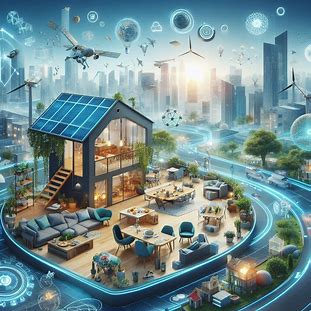As the world faces increasing environmental challenges, technology is playing a crucial role in promoting sustainable living. Innovative solutions are making it easier for individuals and communities to reduce their ecological footprints. Here are ten groundbreaking technologies that are paving the way for a more sustainable future.
1. Solar Energy Solutions
Solar panels harness sunlight to generate electricity, significantly reducing reliance on fossil fuels. Innovations in solar technology, such as solar shingles and transparent solar cells, are making solar energy more accessible and aesthetically pleasing.
External Link: U.S. Department of Energy: Solar Energy Technologies

2. Smart Home Devices
Smart thermostats, lighting, and appliances optimize energy use, allowing homeowners to monitor and reduce their energy consumption. These devices can be controlled remotely, making it easier to implement energy-saving practices.
External Link: Energy Star: Smart Home Products
3. Electric Vehicles (EVs)
Electric vehicles are transforming transportation by providing a cleaner alternative to gasoline-powered cars. With advancements in battery technology, EVs are becoming more efficient and widely adopted.
External Link: U.S. Department of Energy: Electric Vehicles
4. Vertical Farming
Vertical farming utilizes controlled-environment agriculture to grow food in stacked layers, reducing land use and water consumption. This innovative approach can help cities produce fresh produce locally.
External Link: Vertical Farming: The Future of Food

5. Water Purification Technologies
Innovative water purification methods, such as solar water disinfection (SODIS) and membrane filtration, are providing clean drinking water in regions with limited access. These technologies are essential for promoting health and sustainability.
External Link: World Health Organization: Water Purification
6. Sustainable Materials
The development of sustainable materials, such as biodegradable plastics and recycled composites, is reducing waste and the environmental impact of traditional manufacturing processes. Innovations in material science are key to a circular economy.
External Link: Sustainable Materials in Construction

7. Smart Grids
Smart grid technology enhances the efficiency of electricity distribution, allowing for better integration of renewable energy sources. This technology helps balance supply and demand, ultimately reducing greenhouse gas emissions.
External Link: U.S. Department of Energy: Smart Grid
8. Carbon Capture and Storage (CCS)
CCS technology captures carbon dioxide emissions from industrial processes and stores them underground to prevent them from entering the atmosphere. This innovation is critical for mitigating climate change.
External Link: International Energy Agency: Carbon Capture
9. Green Building Technologies
Green building technologies, such as energy-efficient insulation and renewable energy systems, are transforming the construction industry. These innovations help reduce the carbon footprint of buildings while improving occupant comfort.
External Link: U.S. Green Building Council: LEED Certification

10. Waste-to-Energy Technologies
Waste-to-energy technologies convert waste materials into usable energy, reducing landfill waste and providing a renewable energy source. This process helps promote a more sustainable waste management system.
External Link: U.S. Environmental Protection Agency: Waste-to-Energy
Conclusion
Technology is playing a vital role in promoting sustainable living, providing innovative solutions to address environmental challenges. By embracing these advancements, individuals and communities can contribute to a more sustainable and resilient future.







Be First to Comment